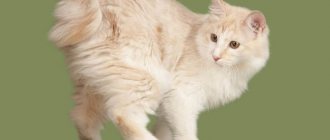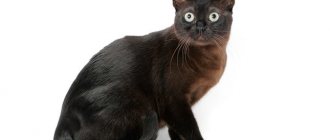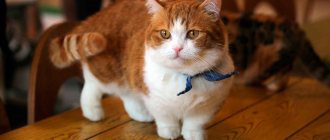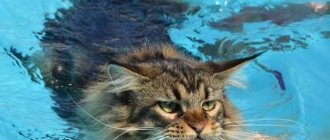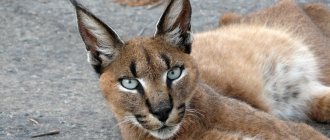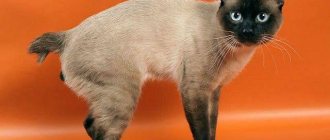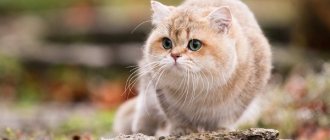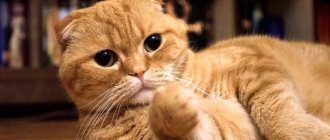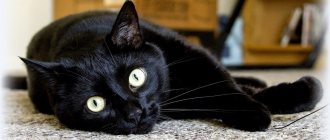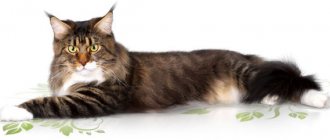Save the article:
What kind of pet can amaze with such an original appearance and variety of breeds as a cat without a tail?
Whether it's a miracle of nature or human intervention, these phenomenal creatures proudly walk around the world today.
Short-tailed cats have proven themselves well not only due to their charming appearance, pom-pom tail or lack thereof, but also due to their remarkable character traits.
If you didn't know that cats such as the Manx and Bobtail varieties exist, then it's time to discover a true feline miracle.
When a person first encounters a fluffy tailless creature, he immediately asks: where could such a wonderful cat come from? There are several explanations for the phenomenon.
Some believe that the first cat with a short tail appeared in Japan in the distant past, although the Japanese Bobtail breed was recognized only recently, in the 2000s.
Tailless Manx, according to legend, inhabited English lands back in the days of the Picts and Roman legionnaires, who allegedly brought the beauties to the island of Great Britain. They loved the cats, noted their unusual appearance and left them to settle everywhere.
Some people believe in the biblical myth that once a cat, who was late for the ark, had its tail pinched and broken off.
There are many versions, but the fact remains: cats without tails are popular today and this popularity is justified.
Tailless cats: history and their types
Felinologists even today cannot agree on how tailless cats appeared. Several versions have been put forward:
- During research work, scientists have repeatedly confirmed the fact that most wild cats gave birth to ordinary babies, but chewed off the kittens’ tails within 24 hours. It is believed that the instinctive ridding of babies from the “weak spot” eventually led to a natural mutation and the animals became short-tailed.
- A natural mutation without prerequisites such as biting off the tail, which led to short tails.
- The third version applies only to American bobtails and pixie bobs. Many believe that these cats descended from lynxes themselves.
A distinctive feature of all tailless cats is their short tail.
Types of tailings
Conventionally, all tailless cats can be divided into two groups: Manx and Bobtail (except for the Pixie Bob and American Bobtail, whose tails should be as close as possible to a lynx). Each of them has its own tail classifications:
- Manx: Rumpy or Dimple Rumpy are the most highly prized cats. Their tail is completely absent; in the place of its growth there is a small hole. Usually it is cats like rumpy that receive titles at shows.
- Riser or rampy riser - their tail consists of 1-3 vertebrae. Such cats can participate in exhibitions if the tail does not exceed 2–4 cm in length.
- Stumpy - from 4 to 14 vertebrae, often lumpy and knobby.
- Longs or tails. The tail is almost the same length as that of tailed cats. Often the tail has to be docked, since the vertebral discs of long-haired cats can ossify.
- Stump:
- from 2 to 8 vertebrae;
- from 4 to 15 vertebrae;
- consists of 5–11 vertebrae;
- the beginning of the tail (approximately 5–7 vertebrae) is identical in structure to the tail of a simple cat;
Photo gallery: types of tails
Cats with a retracted bobtail do not participate in exhibitions
Cats with a tail (or rather, lack thereof) like rumpy are valued the most
The tail-broom looks like a big fluffy pom-pom
The stump tail is characteristic only of bobtails.
The riser-type tail is almost invisible
A stumpy tail is considered a fault.
The longi tail type is similar to a regular tail.
The spiral tail should be well feathered
Manx cats
It is believed that all cats without a tail descended from the Manx. In the description of this breed there are also references to cats with a fluffy long tail. Like other tailless cats, this breed has a calm and good-natured character. Easily adapts to any conditions, very hardy.
Cymric
The second name is Welsh cat. This cat, with short legs and a tail that is practically non-existent, is a direct descendant of the Manx. The body is round in shape, the hair is thick and of different lengths. The character is calm, loves to play, gets along well with children.
Purchasing a cat with a short tail will be an excellent choice: after all, it will become not only a decoration for your home, but also a true friend.
Caring for tailless cats
Tailless cats do not require special care. However, owners should remember a few nuances:
- Tailless cats are prone to infections of the anus and may have difficulty going to the toilet, so the owner should not only closely monitor the well-being of the pet on the tray, but also wipe the cat’s area around the anus after each visit to the tray;
- care for the coat of these cats varies depending on the variety (long-haired/short-haired): each cat will need a rubber brush, a combination comb, a furminator and a bristle brush; short-haired dogs are combed 2 times a week (during the molting period - 4-5 times and 1 time with a furminator), long-haired dogs - 3-4 times a week (during molting - every day and once with a furminator);
Tailless cats are easy to care for
- Regular cleaning of the ears (every 5 days) and daily wiping of the eyes with a natural damp cloth are mandatory, as is trimming the nails.
Character of Manx cats
Manx is an unpretentious pet with a calm character.
Cats become attached to family members and love to spend time with their owner, but will not impose themselves at the wrong time. They are not shy by nature, but can be reserved with guests. Natural curiosity and hunting skills make cats good pets for private homes. If you keep a Manx cat in an apartment, it would be a good idea to take her for walks in a harness.
Cats love to look at water, so instead of a bowl, you can use an automatic drinking fountain to provide your Manx with clean water and entertainment.
They love to hide small things and toys, so don't be surprised if you find a stash behind the sofa during spring cleaning.
Manx cats are friendly and careful with children. If a child starts playing, the cat will prefer to go to a quiet place rather than let out its claws. It is necessary to explain to the baby that the area around the tail, ears and whiskers (whiskers) are especially sensitive places on the cat’s body.
https://youtube.com/watch?v=V1Opw2tvHf4
Health Features of Tailless Cats
In general, tailless cats are in good health: they rarely get colds and are not susceptible to heart disease or infections. But some risk areas are still present.
Bobtails are susceptible to some diseases, but they rarely occur.
Diseases and defects
Genetic diseases are unfamiliar to tailless cats, but acquired ones occur due to the structure of the body and the characteristics of the organism:
- Proctitis (inflammation of the anus) occurs due to the structure of the tail, under which dirt and fecal particles can accumulate, leading to inflammation. It is treated with medications or surgery, depending on the severity and depth of spread.
- Urolithiasis disease. Mostly, Kurilian and Karelian bobtails get sick due to the different acidity of their urine. If your pet frequently urinates bloody urine, experiences pain when going to the toilet and refuses to eat, this is a sure sign of illness. Stones are removed surgically.
- Manx syndrome, or Manx syndrome. Manx and Cymric cats are susceptible to it. In the first 4 months of life, tailless kittens may develop abnormal spine development. This is followed by spina bifida, hernia, difficulty moving and other problems. The defect cannot be treated.
- In general, tailless cats are prone to spinal problems such as lordosis. But, fortunately, they happen rarely.
A feature of all tailless cats is their elongated hind legs (always longer than the front ones). They developed this unusual feature to maintain body balance without a tail.
Japanese Bobtail
The Japanese Bobtail was bred in the Land of the Rising Sun. From time immemorial, indigenous people have had a special relationship with cats. In Japanese national culture, it was customary to consider four-legged “girlfriends” of the devil. According to beliefs, it was in the tail that evil spirits lurked.
The famous “maneki-neko” figurines are a tribute to the Japanese bobtail, which saved the Japanese from a mouse invasion several thousand years ago. Representatives of this breed have a small tail with elongated hair, resembling a pompom, and long hind legs that are longer than the front ones. Any colors are considered acceptable except:
- lilac;
- Abyssinian;
- chocolate;
- colorpoint.
The Japanese are inquisitive, talkative and friendly. These cats quickly get along with small family members and love to chase balls. They show devotion like samurai, choosing only one most beloved master.
Japanese cats without a tail are a native breed without genetic diseases. With proper care and maintenance, their maximum lifespan is 16 years.
Tailless cat breeds
As already mentioned, all tailless cats can be divided into two types: Manx and Bobtail, on the basis of which various breed variations arose.
Manx
The Manx cat is native to the Isle of Man in Great Britain. There are several versions of the origin of this breed:
- The Manx cat became tailless when it was the last one to run into Noah's Ark: the closing door cut off its tail.
- The Manx cat is descended from the Norwegian Forest cat, which was brought to Maine to kill mice.
Manx cats are originally from the Isle of Man.
- Cats chewed off the tails of their kittens so that the Vikings would not cut them off: for them, a cat's tail was a talisman in battle.
- Manx is the result of crossing a rabbit and a cat.
- The most likely version: Manx taillessness is the result of a gene mutation.
It is believed that Manx cats are the progenitors of all tailless cats.
The breed standard was adopted by the CFA in 1920. Distinctive external features of Manx:
- cheeks round and saggy;
- the head is round;
- the body is massive;
- the coat is short, with a dense undercoat;
- the tail is absent or present in the form of a stump of 2–4 cm;
- If there is a tail, small creases and knots are allowed on it.
The psyche and character of the Manx are formed before the age of 5. This is a loyal and affectionate cat, loves games, is active, but not mischievous. Manxes love children and even protect them from danger. The price for Manx starts at 60,000 rubles.
Video: about the Manx breed
Cymric
The breed originated in Canada and was recognized by the CFA in 1976. The Cymric was originally considered a long-haired version of the Manx. These cats were taken from Maine to Wales, then to Canada, where their selection began. During selection, it turned out that in Cymrics the tailless gene is recessive, while in Manx it is dominant. Therefore, they cannot belong to the same breed. The Cymric is considered Canada's national breed. The main difference from the Manx is the long, shaggy coat with a denser undercoat. Also, the cheeks of the Cymric are even more saggy and resemble lynx “whiskers”.
Previously, the Cymric was considered a long-haired version of the Manx.
Due to the lack of a tail, Cymrics do not exactly run: their movements resemble the jumping of a hare.
The character of the Cymric is influenced by the fact that these cats previously served as guards. They are ready to literally do anything to protect their owner; because of this, Cymrics do not get along with other animals at all. Cymrics love to climb tall objects. They are friendly to children and love affection and sleep. Price - from 100,000 rubles.
Pixie bob
In 1985–1986, an American breeder found two kittens with short tails. One of them was close to a lynx in color and size. Their mating resulted in a cat named Pixie. She became the ancestor of pixie bobs. The breed was recognized by TICA in 1993.
Pixie Bobs were created to look like miniature bobcats
Pixie Bob is a polydact breed (individuals are born with extra toes on their paws). The standard is 5 to 7 toes on the front paws.
The need for movement is very high, the pixie-bob must be walked on a leash. They are very smart and cunning and love to learn. External data:
- shoulders, arch of the back and shoulder blades are clearly visible;
- tail no lower than the hock joint and no shorter than 5 cm, with a tassel at the tip;
- there may be extra toes on the paws, the cat does not rely on them while walking;
- on the ears there are black tassels;
- The color is as close as possible to lynx.
The price ranges from 20,000 to 100,000 rubles.
Kurilian Bobtail
The Kuril Bobtail is an indigenous breed that was formed in the harsh conditions of the Kuril Islands. In the early 1950s, the military brought Kuril shorttails to mainland Russia. There, breeders became interested in them and carried out a minimal selection of the breed. In 1995, the WCF adopted a breed standard. External characteristics:
- long or semi-long thick coat with sparse undercoat;
- tail no shorter than 3 and no longer than 9 cm;
- the muzzle is wedge-shaped, wide and short;
- The body is massive, there are small tassels on the ears.
Kurilian Bobtails are relatives of the Siberian cat.
A self-confident, independent and self-sufficient pet does not consider a person to be the master or a higher being. The key to warm and friendly relations with representatives of this breed is mutual respect and communication as equals. The Kurilian Bobtail is a cat with a reinforced concrete psyche, calm and fearless. They calmly tolerate loneliness and are not inclined to impose themselves.
The Kurilian Bobtail calmly tolerates loneliness and demands respect for itself.
The price of Kurils is from 10,000 rubles.
Video: features of Kurilian Bobtails
American Bobtail
Tourists vacationing in Southern Arizona near a former Indian settlement discovered a kitten with a short tail, which was taken in by a young couple. In their family there lived a Siamese cat, with which he was crossed. The offspring included several kittens with short tails. They were given to professional breeders. As a result of crossing them and their father with Ragdolls, Siamese, Manx, Burmese and mongrel cats, the American Bobtail was developed.
The American Bobtail may well be a descendant of the lynx
There is a high probability that the ancestors of the kitten found in Arizona included a bobcat.
However, by the 1980s the breed had almost disappeared. To restore bobtails, they began to cross them only with cats that had a natural mutation of a shortened tail.
In 2000, when the breed was recognized by the CFA, there were only 215 American Bobtails. External features of American Bobtails:
- eyebrows are expressive and protruding;
- eyes are deep-set, yellow or green;
- tabby pattern, the main color of the coat is from cream to brown-red, tabby stripes are black or brown.
They are very active, can be mischievous if there is a lack of movement and play, and they need a lot of different toys. An interesting feature is that they easily learn to open locks and do not like locked doors. They are usually friendly towards other animals, but often fight for dominance in the “pack”. They do not tolerate loneliness and moving well. Price - 10,000–30,000 rubles.
Video: about the American Bobtail
Japanese Bobtail
The true origin of the Japanese Bobtail is unknown. The first mention of this aboriginal breed dates back to the 12th century. In 1968, several kittens were taken from Japan to the United States. A selection was carried out there and three years later the breed was recognized.
In Japan, tailless cats were considered symbols of happiness and good luck. Bobtails were immortalized in figurines called maneki-neko. And tailed purrs were considered servants of dark forces and underwent tail docking surgery.
Japanese Bobtails bring good luck to owners
Japanese Botails are unusually good-natured, they are people-oriented, devoted to their owner and his entire family. Cats love traveling and can withstand stressful situations. External features:
- light and refined body;
- long thin paws;
- short, thin coat with almost no undercoat;
- the tail is well furred;
- the ability to bend and straighten the tail, when bent it is no longer than 8 cm, when straightened it is no more than 15 cm;
- Van, bicolor and tricolor colors are preferred.
The price of Japanese bobtails is 15,000–75,000 rubles.
Video: about the Japanese Bobtail
Mekong Bobtail
Short-tailed cats were often found among the cats that lived in Thailand in the 15th–19th centuries. After the future Siamese were brought to Europe, these cats were considered “rejected” and decided not to be allowed into selection. In Russia, they became interested in unusual cats and, through selection, developed a new breed, which was recognized as native Russian. The breed received WCF recognition in 2004.
Mekong Bobtails are relatives of the Thai and Siamese
It is said that the tails of the Mekongs became curled and shortened when they guarded ancient vases in palaces and temples with their tails wrapped around them.
Mekongs are very curious, they are the main “activists” in the family, they are very talkative and open cats who love affection. They have a negative attitude towards strangers and do not like other animals, but provided they are friendly, they get along quite well with them.
Mandatory external characteristics:
- only color-point colors;
- Thai cat body type;
- exclusively blue eye color;
- the tail must be wrapped in a donut shape.
Price - from 4,000 to 20,000 rubles.
Video: Mekong Bobtails
Karelian Bobtail
Karelian Bobtails are an indigenous breed that has lived for a long time on the shores of Lake Ladoga. They were noticed and brought to St. Petersburg in 1987. The selection lasted 7 years, after which the breed was recognized by the WCF.
They are very social, get along easily with children and animals, but can be demonstratively offended. Karelians often take on the role of guard and “head of the family.”
Unfortunately, the Karelian Bobtail is an endangered breed
Male Karelian bobtails do not mark, and females go into heat almost unnoticed.
External differences:
- the hair on the tail is longer than the hair on the body, creating the appearance of a pompom;
- the head is round and massive;
- the forehead and cheekbones are high, and the cheeks are “flat”.
Price - from 35,000 to 70,000 rubles.
Table: comparative characteristics of tailless breeds
| Characteristic | Manx | Cymric | Pixie bob | Kurilian Bobtail | American Bobtail | Japanese Bobtail | Mekong Bobtail | Karelian Bobtail |
| Height | From 27 to 32 cm | From 27 to 30 cm | From 25 to 33 cm | From 25 to 30 cm | From 30 to 33 cm | From 23 to 28 cm | OK. 23–28 cm | From 23 to 29 cm |
| Weight | From 3.5 to 7 kg | From 3.5 to 6 kg | From 5 to 9 kg | From 5 to 8 kg | From 3 to 8 kg | From 3 to 4 kg | From 4 to 6 kg | From 2.5 to 6 kg |
| Lifespan | 12–15 years | 15–16 years old | 13–15 years old | 15–17 years old | 14–17 years old | 15–17 years old | 18–20 years old | 10–13 years |
Pixiebob
- The tail part of the presented specimens is shortened and does not really stand out. It is difficult to confuse these animals with other individuals classified as felines. According to their external characteristics, they are similar to lynxes, and the absence of a tail is only touching.
- Pets are endowed with ears of the correct build, on which there are tassels of hairs at the tips. Yes, there are whiskers, which, again, bring these felines closer to lynxes. To have such a miracle in your home is real happiness.
- The cats are large in size; according to estimates, the body weight can be 9 kg. However, average individuals weigh approximately 7 kg. The body is well built and muscular, the spine is strong. The animal represents a hunter and a friendly family member in one package.
- Initially, representatives of the family were bred in the United States of America. After some time, they became more popular, and breeders began working on cats in Canada and other countries. These cats are characterized by an increased number of fingers, which is why they are called cats with mittens.
Hybrid and wild tailless cats
Hybrid tailless animals are the result of crossing several breeds. They have not yet received recognition, so little is known about them. The list of hybrids is small:
- Alaskan snow cat, or snow bob, is a white variation of the American bobtail;
- Scythian-toy-bob is a Russian breed of miniature cats, a descendant of the Mekong Bobtail and cats with the miniature gene, distinguished by its color-point color;
- oohee-bob - the result of crossing a Siamese and a Manxam - as a result, the color-point Manx was obtained;
- The Highlander is the most unusual short-tailed cat, obtained from crossing an American Curl and an American Bobtail, and inherited a short tail and curled ears from its parents.
Photo gallery: hybrid short-tailed cats
Snow beans are born quite rarely
Compared to an ordinary cat, the Scythe-toy-bob is a real baby
The Oohee Bob is a type of American Bobtail.
The Highlander cat has a short tail and Curl ears.
The wild family of short-tailed cats is limited to lynxes and caracals. There are the following types of lynx:
- Iberian (Pyrenean) lynx;
- Canadian lynx;
- red lynx;
- common lynx.
Photo gallery: wild short-tailed cats
The second name of the caracal is the steppe lynx. The Iberian lynx is one of the rarest mammals on the planet. The common lynx is listed in the Red Book of Russia.
The Latin name for the red lynx is Lynx Rufus. The Canadian lynx has a silver coat with a reddish tint.
Video: facts about lynxes
Upbringing
American Bobtails have developed intelligence. They easily learn the rules of behavior in the house and quickly get used to using a tray and scratching post.
Kittens usually receive basic socialization in the breeder's home. In the new apartment, the baby needs to be shown a potty and be closely monitored in the first few days. If the short-tailed cat does not immediately remember where to relieve himself, he begins to worry, sit down, the cat must be carefully transferred to the tray. A smart kitten will quickly understand what is required of him. You cannot hit your pet for peeing in the wrong place. His negative emotions will be associated with the process of evacuation itself, and not with the place. The cat will begin to hide in the corners, and it will be much more difficult to train him to use the toilet.
You need to immediately wean your Bobtail away from playing with your hands. A grown large animal can unknowingly cause serious injury to a person. When the baby begins to bite or scratch, the game must be immediately interrupted and offered a special ball, fishing rod, teaser or mouse instead of fingers. An active Snow-Bob will be happy to engage in special “entertainment” activities and will not tear up furniture or books.
Thanks to their extraordinary mental abilities, Bobtails are easy to train and can master some simple commands. The main thing is to organize classes in the form of a game, then the Yankees will happily study, enjoying the additional attention from the owner.
If a child does something illegal, it is enough to reprimand him in a stern voice. American bobtails try not to disappoint their owners and have a great sense of intonation. When a young cat loses control of energy during play, it is permissible to spray it with a spray bottle. Representatives of this breed do not like water very much. He will associate pranks with unpleasant sensations. In general, Bobtails are very obedient; problems with their upbringing rarely arise.
qualities)
Due to the fact that the breeds in question have virtually no tail, they have well-developed other muscles. As for the very character of cats, they are distinguished by kindness and affection. Such individuals will become excellent companions for one person or perhaps a large family.
Short-tailed cats are quite playful, so you won’t feel sad. Individuals are quite indifferent to other animals in the house, so you can safely get someone else. Cats also have high intelligence. Thanks to this, you can safely train the animal. Rest assured, Murka will understand you perfectly.
Cymric
Cymrik breed history: Cymrik is a semi-longhaired Manx, that is, a semi-longhaired tailless cat. However, it should be clarified that not all Cymrics are born tailless.
This breed is the result of a natural mutation that occurred back in the Middle Ages. However, full-fledged selection of Cymrics began only in the 60s. XX in Canada. Through the efforts of Canadian felinologists, the new breed was recognized in 1990.
Cymric Personality: Cymrics are friendly, intelligent, and non-aggressive.
Disqualifying faults
A number of defects lead to disqualification from breeding. They are not very common and significantly reduce the cost of the kitten, since in this case it is not valuable for breeding. Kurils with the following defects are subject to culling:
- tail length that exceeds 13 cm;
- complete absence of a tail;
- deafness;
- undescended testicles or one testicle;
- a very short tail that has no bends or kinks;
- erosion of the mucous membrane in the anus;
- spinal deformity;
- amputated claws.
Non-disqualifying defects include the following:
- insufficient length of the front legs;
- excessively bulging or too deep-set eyes;
- excessive arching of the back;
- extra vertebrae in the tail;
- cheekbones too high;
- narrowed head;
- undeveloped undercoat;
- sharp tips of the ears;
- disproportionately long body.
With minor defects, cats are allowed for breeding, but most often to produce non-elite offspring, which will have an average price. Such individuals do not occupy high places at exhibitions.
Toy-bob (skif-toy-bob, skif-tay-don, skiff-tay-toy-don)
Toy-bob history of the breed: In 1988, in a Rostov nursery, a dwarf bob-tailed kitten, Kutsy, was born to two Mekong bobtails, and he laid the foundation for a new breed - dwarf Thai bobtails, toy-bobs.
In 2009, toy beans were partially recognized by TICA.
Toy Bob Personality: Toy Bobs are affectionate, sociable and playful.
Description, what it looks like, what colors there are
The appearance and bright colors of the Bobtail immediately attracts attention. These cats have well-developed muscles, stockiness and a strong build. Sexual dimorphism in representatives of the breed is pronounced - cats are much larger than cats
The fact that Kurils have wild roots is clearly visible in their appearance, both in long-haired and short-haired varieties.
Sexual dimorphism in representatives of the breed is pronounced - cats are much larger than cats. The fact that Kurils have wild roots is clearly visible in their appearance, both in long-haired and short-haired varieties.
Black
The color can be either completely black or with a small splash of white hair on the chest and ends of the paws. In old age, Kurils with this color may develop a brown tint.
Black and white color
Black marble
This color is inherited from the wild ancestors of Bobtails and gives the cat a particularly impressive appearance. This color belongs to the tabby color and is most often found among Kurbobs.
Black and white
Black and white is quite varied. It can be a basic black color interspersed with white, randomly located. Another option is a white base interspersed with black. Black and white striped color is very rare.
White
Solid color, in which a blue iris is allowed. The long-haired representatives of the breed look especially impressive.
Ginger
Available in solid or tabby color. The category of redheads includes red and cream colors. The presence of white inclusions is allowed.
Grey
Solid and tabby colors are possible. The presence of inclusions of white wool is allowed. Blue colors also fall into this category.
Tortoiseshell
Kurbobs have tortoiseshell colors according to the standard, only black and blue are possible. In black suit with this type of color there are inclusions of brown, red and white wool, with a predominance of dark tones. The blue color combines light and dark wool of a silver-gray, bluish color. This option is less common and looks especially impressive.
Japanese Bobtail
From the name of the breed of these animals it is immediately clear where they come from.
The main difference of this species is a very slender, beautifully built physique. Also, these cats are somewhat smaller in size than all the breeds described above. The eyes deserve special attention, since their specific shape and bright color are the main symbols of the breed.
The head of Japanese Bobtails is triangular in shape, with wide erect ears.
Such animals have a tail, but it is unusually small, sometimes even completely invisible. Their fur is smooth, fluffy and soft. These cats practically do not shed. As for colors, animals with three colors are most often found.
The peak demand for these animals occurred in the post-war years. And this species of animal was officially recorded in America in the 1960s.
Japanese Bobtail
Interesting Facts
During the existence of the Manx tailless cat, many interesting things have been associated with it:
- There is a beautiful legend associated with bob-tailed cats. According to legend, it was this animal that was the last to run into Noah’s ark, and its tail was accidentally pinched. The cat chose to remain without this part of the body and go on a rescue voyage.
- Residents of the Isle of Man are proud of tailless cats and believe that they bring good luck. These animals have long been depicted on coins, paintings and jewelry.
- The museum in the capital of the Isle of Man contains a book dating from the 17th-18th centuries. – it contains a detailed description of cats of this breed.
What to feed?
High-quality and balanced nutrition is the basis for good health and proper development of short-tailed cats. The animal is not picky about food. If desired, you can feed your cat ready-made factory-made dry or wet food of premium and superpremium classes. But the pet will not refuse natural food. The daily diet must include lean boiled meat, steamed sea fish, cottage cheese, kefir, fermented baked milk, and natural yogurt. Porridge will help provide the body with energy: rice, oatmeal, buckwheat. For normal digestion, it is useful to add vegetables to your diet, such as pumpkin, zucchini, and cauliflower.
